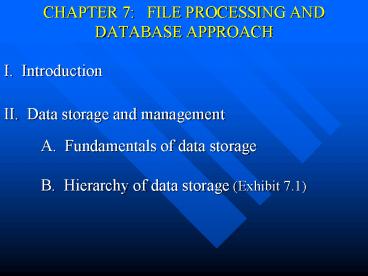CHAPTER 7: FILE PROCESSING AND DATABASE APPROACH - PowerPoint PPT Presentation
1 / 10
Title:
CHAPTER 7: FILE PROCESSING AND DATABASE APPROACH
Description:
I. Introduction. II. Data storage and management. A. Fundamentals of data storage ... 2. Approaches to data management - File-oriented approach (Exhibit 7.4) ... – PowerPoint PPT presentation
Number of Views:950
Avg rating:3.0/5.0
Title: CHAPTER 7: FILE PROCESSING AND DATABASE APPROACH
1
CHAPTER 7 FILE PROCESSING AND DATABASE APPROACH
- I. Introduction
- II. Data storage and management
- A. Fundamentals of data storage
- B. Hierarchy of data storage (Exhibit 7.1)
2
- II. Data storage and management (continued)
- C. Field and record characteristics
- 1. Field formats
- 2. Record lengths
- - Fixed-length records (Exhibit 7.2A)
- - Variable-length records (Exhibit 7.2B)
- 3. Record identifiers
- - Primary key
- - Secondary keys
3
- II. Data storage and management (continued)
- D. Data management
- 1. Objectives of data management
- (Exhibit 7.3)
- 2. Approaches to data management
- - File-oriented approach (Exhibit
7.4) - - Database approach (Exhibit 7.5)
4
- III. File-oriented versus database approaches
- A. Types of files (Exhibit 7.6)
- B. The file-oriented approach (Exhibit 7.7)
- C. The database approach
- 1. Database fundamentals (Exhibit 7.8)
- 2. Advantages of the database approach
(Exhibit 7.9) - 3. Disadvantages of the database approach
- (Exhibit 7.9)
5
- IV. File organization access methods
- A. File storage and access basics (Exhibit
7.10) - B. Sequential file organization
- 1. Storage of sequential files
- 2. Processing of sequential files (Exhibit
7.11) - 3. Advantages disadvantages
6
- IV. File organization access methods
(continued) - C. Random access file organization
- 1. Storage of random access file (Exhibit
7.12) - 2. Processing of random access files
- 3. Advantages and disadvantages
- D. Indexed sequential file organization (ISAM)
- 1. Storage and processing of ISM files
(Exhibit 7.13) - 2. Advantages and disadvantages
7
- V. Database management systems
- A. Conceptual modeling for database design
- - Entity-relationship approach
(Exhibit 7.14) - - Object-oriented modeling (Exhibit
7.15) - B. Logical modeling for database design
- 1. Hierarchical model (Exhibit 7.16)
- 2. Network model
- - simple (Exhibit 7.17)
- - complex (Exhibit 7.18)
- 3. Relational model (Exhibit 7.19)
8
- V. Database management systems (continued)
- C. Database normalization (Exhibit 7.20)
- 1. First-normal-form (1NF) (Exhibit 7.21)
- 2. Problems with 1NF
- 3. Second-normal-form (2NF) (Exhibit 7.22)
- 4. Problems with 2NF
- 5. Third-normal-form (3NF)
- (Exhibits 7.23 and 7.24)
9
- V. Database management systems (continued)
- D. Physical database design and
implementation - E. Maintenance of a database
- F. DBMS languages and interfaces
- 1. Data Definition Language (DDL)
- 2. Data Manipulation Language (DML)
- (Exhibit 7.25)
- 3. Data Query Language (DQL)
- 4. Structured Query Language (SQL)
- (Exhibits 7.26 and 7.27)
10
- V. Database management systems (continued)
- G. DBMS control security































